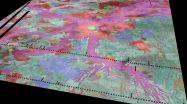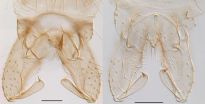Origins of the Hawaiian hoary bat revealed by GVSU professor and research team
2015-06-18
(Press-News.org) ALLENDALE, Mich. -- A Grand Valley State University biology professor and her team of scientists have determined new information about an endangered species in the U.S., which could impact its protection under the Endangered Species Act.
The study, "Two Tickets to Paradise: Multiple Dispersal Events in the Founding of Hoary Bat Populations in Hawai'i," was recently published in PLOS ONE at http://journals.plos.org/plosone/article?id=10.1371/journal.pone.0127912.
The study, led by Amy Russell, associate professor of biology at Grand Valley, reveals that the Hawaiian hoary bat migrated to the islands from the Pacific coast of North America in two separate waves more than 9,000 years apart.
"Because the Hawaiian hoary bat is the only living native land mammal in Hawaii and it's on the U.S. Fish and Wildlife Service's endangered species list, we want to know everything possible about its genetic history, relationships to other bats and if there are unique subpopulations on different Hawaiian islands," Russell said.
These two separate migrations represent the longest overwater flight followed with the founding of a new population for any species of bat, of which there are 1,300. The study estimates that the earlier migration from mainland to North America to Hawai'i happened around 10,000 years ago, while a more recent migration occurred approximately 800 years ago.
Russell said the results of this study suggest that the current legal protection of these endangered bats may be inadequate or at least misdirected.
"By showing evidence of two distinct lineages on the islands, we are providing the U.S. Fish and Wildlife Service with scientific justification for recognizing two taxa on the islands and protecting them appropriately," Russell said. "The current recovery plan doesn't recognize that there are two distinct taxa on the islands; therefore, monitoring of population size and habitat use that treats all Hawaiian bats as a single unit is likely providing measures that are overestimated and not accurate for either taxon."
To collect their data, the research team used bits of wing tissue and DNA sequencing and analytical tools to estimate the time and place of origin for the Hawaiin hoary bat.
Researchers contributing to this effort represent Grand Valley, University of Hawai'i at Hilo, Western Michigan University, EcoHealth Alliance and U.S. Geological Survey.
INFORMATION:
For more information, contact Amy Russell at (616) 331-8929 or russelam@gvsu.edu.
ELSE PRESS RELEASES FROM THIS DATE:
2015-06-18
(Philadelphia, PA) - A little more than a decade ago, researchers discovered that all cells secrete tiny communications modules jammed with an entire work crew of messages for other cells. Today, a team of researchers, led by stem cell researcher Raj Kishore, PhD, Director of the Stem Cell Therapy Program at the Center for Translational Medicine at Temple University School of Medicine (TUSM), is harnessing the communications vesicles excreted by stem cells and using them to induce the damaged heart to repair itself. Their research is the June 19 cover story in the leading ...
2015-06-18
PROVIDENCE, R.I. [Brown University] -- An international team of scientists has found some of the best evidence yet that Venus, Earth's nearest neighbor, is volcanically active.
In combing through data from the European Space Agency's Venus Express mission, the scientists found transient spikes in temperature at several spots on the planet's surface. The hotspots, which were found to flash and fade over the course of just a few days, appear to be generated by active flows of lava on the surface.
"We were able to show strong evidence that Venus is volcanically, and thus ...
2015-06-18
Currently, there are more than 350 million type 2 diabetics and according to the World Health Organization (WHO) by 2030 it will be the 7th leading cause of death worldwide.
The hallmark of type 2 diabetes is insulin resistance, which is initially compensated for by an increase in beta cell size (responsible for producing insulin). However, the beta cells of such patients will eventually collapse and die, leading to full blown type 2 diabetes.
Researchers from the Laboratory of Cancer Metabolism at IDIBELL, led by Sara Kozma, have shown in animal models that inhibition ...
2015-06-18
NEW YORK (June 18, 2015) - Proper laundering and handling are important in achieving and maintaining the hygienically-clean quality of healthcare fabrics and textiles delivered to the point of care, according to a new review that highlights evidence-based strategies to inhibit potentially serious contamination. The review, based on findings and recommendations from peer-reviewed studies, as well as current standards and guidelines, is published online in Infection Control & Hospital Epidemiology, the journal of the Society for Healthcare Epidemiology of America (SHEA). ...
2015-06-18
Over 35 million people worldwide are currently infected by HIV. Antiviral therapies can keep the virus from multiplying. However, no drug can cure infection so far, because various cell types continue to carry the virus in a latent, i.e. quiescent, state. Scientists of Helmholtz Zentrum Muenchen have now established a model for latent HIV infection of brain cells. The researchers used this model to identify various compounds that affect latency of the virus in the brain. This study was published in the journal AIDS.
"Chronic infection is caused by long-lived cells with ...
2015-06-18
Revisiting original types and DNA analysis exposed hidden diversity in minute non-biting midges. Two species new to science were discovered and one misapprehended species was removed by following the traces back to the source in Brussels. The study was published in the open access journal ZooKeys.
"Nobody suspected a mystery until we solved it", says Elisabeth Stur, the senior author of the paper describing the misconception. - "Maybe even some will be upset that we discovered this long lasting misidentification".
It all started with Elisabeth Stur and Torbjørn ...
2015-06-18
Scientists at the University of Southampton think that Next-Generation Sequencing (NGS) of invasive organisms holds the key to furthering our understanding of ecological and evolutionary processes.
In a review of recent studies published in Current Zoology, the researchers say the technique is underutilised in the field of invasion biology. They believe NGS has the potential to transform our understanding of why non-native species adapt and thrive in new environments, often at the expense of their indigenous competitors.
The key to the success of biological invasions ...
2015-06-18
New research conducted by archaeologists from the University of York and the Universitat Autònoma de Barcelona, in collaboration with members of Tel Aviv University, reveals striking insights into the living conditions and dietary choices of those who lived during the Middle Pleistocene some 300,000 - 400,000 years ago.
The article, published in Quaternary International, describes the study in which samples of plaque were extracted from the teeth of three Lower Palaeolithic hominins who lived in Qesem Cave, Israel.
Conducting optical and chemical analyses on the ...
2015-06-18
BUFFALO, N.Y. -- Researchers at the University at Buffalo have discovered a previously unknown neural pathway that can regulate changes made in the brain due to cocaine use, providing new insight into the molecular basis of cocaine addiction.
"Addiction is a life-long affliction manifested by episodes of relapse, despite prolonged abstinence," says Amy Gancarz, PhD, lead author of the study, which was published on June 1 in an Advance Online Publication in Nature Neuroscience. "There is a need to more fully understand the long-term molecular changes in the brain involved ...
2015-06-18
This new NASA/ESA Hubble Space Telescope image shows a gathering of four cosmic companions. This quartet forms part of a group of galaxies known as the Hickson Compact Group 16, or HCG 16 -- a galaxy group bursting with dramatic star formation, tidal tails, galactic mergers and black holes.
This quartet is composed of (from left to right) NGC 839, NGC 838, NGC 835, and NGC 833 -- four of the seven galaxies that make up the entire group. They shine brightly with their glowing golden centres and wispy tails of gas [1], set against a background dotted with much more distant ...
LAST 30 PRESS RELEASES:
[Press-News.org] Origins of the Hawaiian hoary bat revealed by GVSU professor and research team


